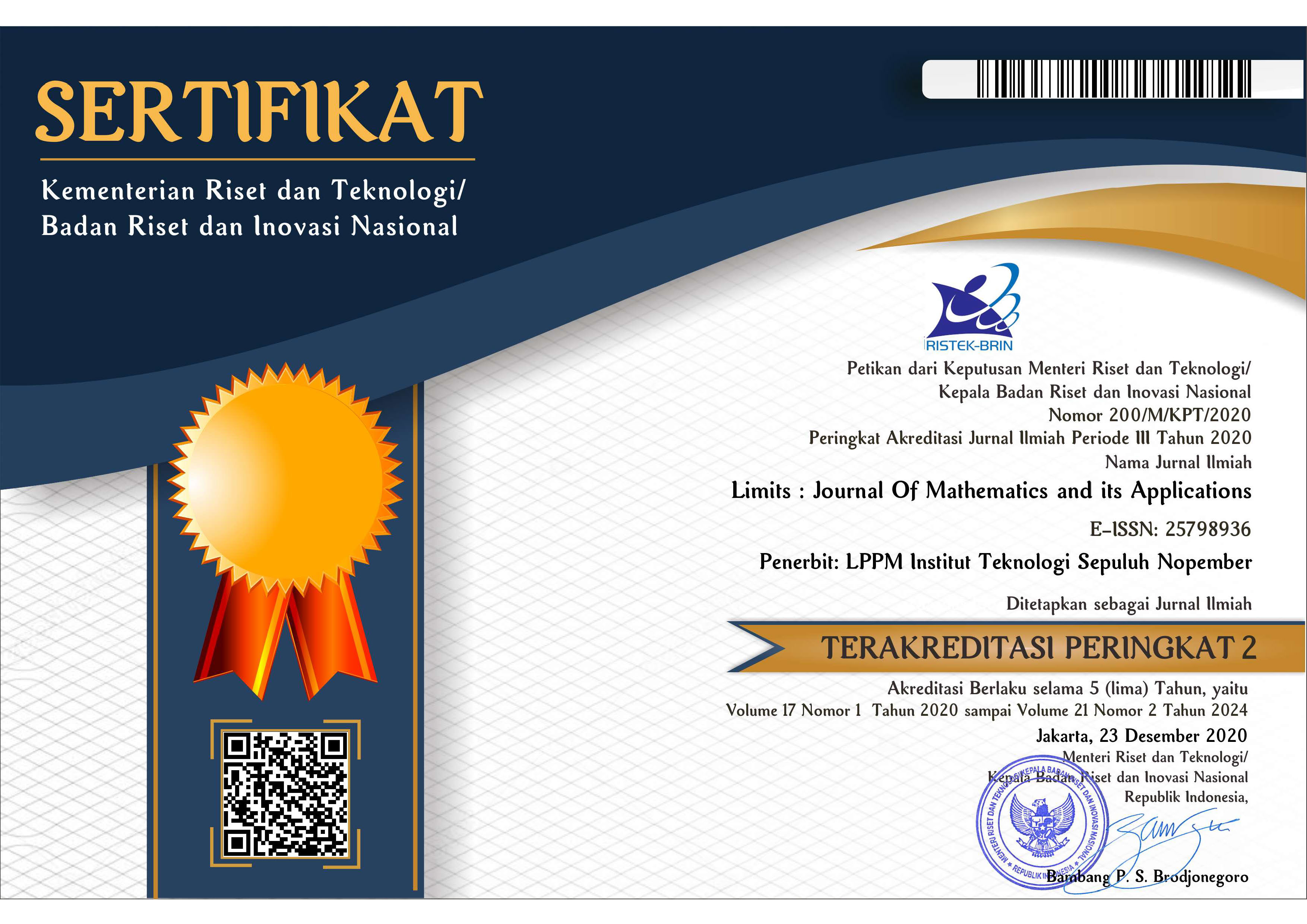Kendali Optimal Model Pertumbuhan Mikroalga dalam Chemostat
Abstract
Keywords
Full Text:
PDFReferences
H. Hadiyanto and N. P. Adetya, Biorefinery Mikroalga, 1st ed. Semarang: EF Press Digimedia, 2019. [Online]. Available: http://eprints.undip.ac.id/72170/1/buku_Refenery_DONE.pdf
I. Chang, A. K. Prasidhi, J. Im, and G. C. Cho, “Soil strengthening using thermo-gelation biopolymers,” Constr. Build. Mater., vol. 77, 2015, doi: 10.1016/j.conbuildmat.2014.12.116.
D. Amalia, B. Guritno, and G. Firuliadhim, “Pengaruh Biopolimer Pada Stabilitas Lereng Swelling soil,” Borneo Eng. J. Tek. Sipil, vol. 5, no. 3, 2021, doi: 10.35334/be.v5i3.2099.
M. R. Droop, “SOME THOUGHTS ON NUTRIENT LIMITATION IN ALGAE,” J. Phycol., vol. 9, no. 3, 1973, doi: 10.1111/j.1529-8817.1973.tb04092.x.
J. Monod, “Technique, Theory and Applications of Continuous Culture.,” Ann. Inst. Pasteur, vol. 79, no. 4, 1950.
A. Thornton et al., “Modeling, optimization of algae growth,” 2010.
H. Sovová and R. P. Stateva, “New developments in the modelling of carotenoids extraction from microalgae with supercritical CO2,” J. Supercrit. Fluids, vol. 148, 2019, doi: 10.1016/j.supflu.2019.03.002.
H. F. L. García and N. L. Mejía, “Mathematical Model of a Bubble Column for the Increased Growth of Arthrospira platensis and the Formation of Phycocyanin,” Int. J. Technol., vol. 12, no. 2, 2021, doi: 10.14716/ijtech.v12i2.4256.
E. O. Alzahrani, M. M. El-Dessoky, and P. Dogra, “Global dynamics of a cell quota-based model of light-dependent algae growth in a chemostat,” Commun. Nonlinear Sci. Numer. Simul., vol. 90, 2020, doi: 10.1016/j.cnsns.2020.105295.
O. Bernard, “Hurdles and challenges for modelling and control of microalgae for CO2 mitigation and biofuel production,” IFAC Proc. Vol., vol. 43, no. 5, 2010, doi: 10.3182/20100705-3-be-2011.00111.
N. Izzati, “ANALISIS KESTABILAN DAN KENDALI OPTIMAL PADA MODEL DINAMIKA MODULASI ENERGI CAHAYA DALAM FOTOSINTESIS ALGA,” Reaktom Rekayasa Keteknikan dan Optimasi, vol. 2, no. 1, 2017, doi: 10.33752/reaktom.v2i1.152.
Mardlijah, A. Fadhillah, and L. Hanafi, “Performance Analysis of Linear Quadratic Regulator Method in Microalga Growth with Control of Light Intensity,” in Journal of Physics: Conference Series, 2020, vol. 1463, no. 1. doi: 10.1088/1742-6596/1463/1/012004.
Azim, R. Ratianingsih, and N. Nacong, “Model Matematika Kendali Optimal Intensitas Cahaya Dan Nutrisi Pada Pertumbuhan Mikroalga Dengan Menggunakan Metode Pontryagin,” J. Ilm. Mat. DAN Terap., vol. 17, no. 1, 2020, doi: 10.22487/2540766x.2020.v17.i1.15173.
Mardlijah, A. Jamil, L. Hanafi, and S. Sanjaya, “Optimal control of algae growth by controlling CO 2 and nutrition flow using Pontryagin Maximum Principle,” in Journal of Physics: Conference Series, 2017, vol. 890, no. 1. doi: 10.1088/1742-6596/890/1/012042.
D. Subbaram Naidu, Optimal control systems. CRC Press, 2002. doi: 10.1515/9783110306637-005.
W. Ningsih, S. Sumardi, and ..., “Kendali Optimal Model Matematika Penyebaran Rumor pada Jaringan Sosial Daring dengan Pemberian Pernyataan Balasan,” … dan Nilai-Nilai …, 2020.
W. Ningsih, “Pengendalian Optimal Model Epidemi Flu Burung pada Unggas-Manusia dengan Pengobatan pada Manusia dan Depopulasi pada Unggas,” Sq. J. Math. Math. Educ., vol. 3, no. 1, 2021, doi: 10.21580/square.2021.3.1.7871.
D. Idayani and S. Subchan, “Optimal Control of Multi-Supplier Inventory Management with Lead Time,” Int. J. Comput. Sci. Appl. Math., vol. 6, no. 1, 2020, doi: 10.12962/j24775401.v6i1.5040.
R. W. Dewanti and S. Subchan, “Kendali Optimal Model Diversifikasi Beras dan Non-beras dengan Target Akhir Konsumsi,” SPECTA J. Technol., vol. 1, no. 3, 2019, doi: 10.35718/specta.v1i3.88.
Subiono, “Sistem Linear dan Kontrol Optimal,” p. 255, 2013.
Y. Nie, O. Faqir, and E. C. Kerrigan, “ICLOCS2: Try this Optimal Control Problem Solver before you Try the Rest,” 2018. doi: 10.1109/CONTROL.2018.8516795.
S. Subchan and R. Zbikowski, Computational Optimal Control: Tools and Practice. 2009. doi: 10.1002/9780470747674.
DOI: http://dx.doi.org/10.12962%2Flimits.v19i2.13837
Refbacks
- There are currently no refbacks.
Jumlah Kunjungan:

Limits: Journal Mathematics and its Aplications by Pusat Publikasi Ilmiah LPPM Institut Teknologi Sepuluh Nopember is licensed under a Creative Commons Attribution-ShareAlike 4.0 International License.
Based on a work at https://iptek.its.ac.id/index.php/limits.






